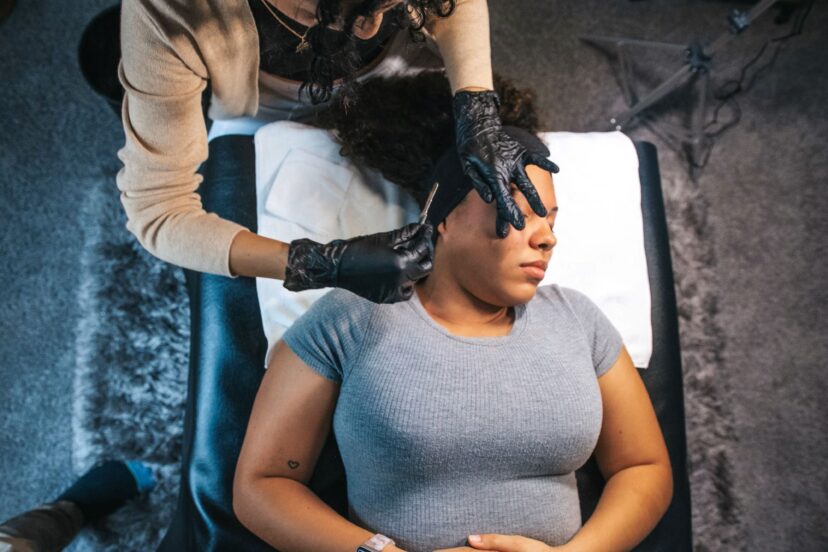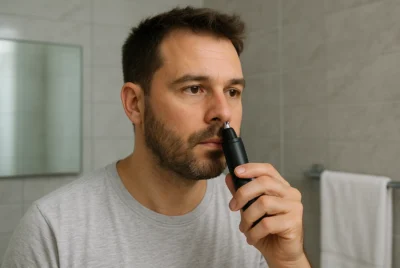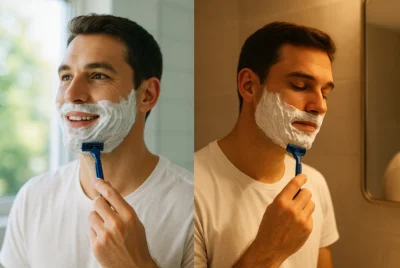Dermaplaning vs Shaving: Which Technique is Right for You?
Post Disclaimer
*We may earn a commission for purchases made using our links. Please see our disclosure to learn more.
Are you standing in front of the mirror pondering whether to grab that razor or book an appointment for dermaplaning? Hair removal and facial exfoliation can be confusing, with so many methods claiming to leave your skin smooth and glowing. It’s a daily dilemma: wherein you stuck to choose between which technique is right for you, which dermaplaning vs shaving.
Here’s something intriguing – dermaplaning is not just about getting rid of unwanted fuzz; it offers a deeper exfoliation that rejuvenates your skin far more than ordinary shaving could manage.
In this blog post, we’ll dive into the nitty-gritty of both techniques, weighing their pros and cons based on various factors like skin type and budget. You’ll walk away ready to make an informed decision that best fits your lifestyle needs. Ready for smoother days ahead? Let’s unveil which path leads to radiant skin!
Understanding Dermaplaning vs Shaving
Dermaplaning is a cosmetic procedure that involves using a scalpel to gently scrape off the top layer of dulling dead skin cells and peach fuzz. Shaving, on the other hand, is the process of removing hair using a razor or electric shaver.
Both techniques aim to achieve smooth and glowing skin, but they differ in their approach and benefits.
What is Dermaplaning?
Dermaplaning takes exfoliation to the next level, going beyond traditional shaving. A skilled aesthetician uses a special surgical scalpel to gently scrape away the top layer of dulling dead skin cells. This process reveals a smoother, brighter complexion and gets rid of peach fuzz at the same time.
Unlike regular shaving methods, this technique allows for deeper penetration of skincare products, enhancing their effectiveness on your freshly exfoliated skin. Its popularity stems from its ability to make facial features appear more defined and provide an impeccable canvas for makeup application.
Plus, with dermaplaning done by professionals, you get added assurance that it’s safe and tailored specifically for your skin’s needs.
How does it work?
Dermaplaning involves using a sharp blade to gently scrape off the top layer of dead skin cells and fine vellus hair, commonly known as peach fuzz. This process effectively exfoliates the skin, leaving it smooth and radiant.
The precise technique also helps skincare products penetrate deeper, resulting in improved absorption and efficacy. Moreover, dermaplaning promotes cell turnover, revealing fresher and younger-looking skin.
Additionally, the procedure triggers the body’s natural healing response by stimulating collagen production for firmer and more supple skin. Unlike shaving, which only removes hair on the surface level of the skin, dermaplaning provides a thorough exfoliation that unclogs pores and reduces acne breakouts while eliminating dullness.
What is Shaving?
Shaving is a common method of removing facial hair using a razor or an electric shaver. This technique involves cutting the hair off at skin level, providing a smooth appearance. Shaving is often preferred for its convenience and accessibility, allowing individuals to maintain their desired look at home without professional assistance.
Additionally, it offers a quick solution for those with time constraints and can be easily incorporated into daily grooming routines.
Shaving also poses some risks such as razor burns, cuts, or ingrown hairs if not performed carefully. While it may not offer the same comprehensive skincare benefits as dermaplaning, shaving remains a popular choice due to its simplicity and affordability.
How are the two different?
Understanding the distinctions between dermaplaning vs shaving is crucial for deciding on the right hair removal and skincare method. Both involve a blade and the removal of facial hair, but their techniques and outcomes differ significantly.
| Dermaplaning | Shaving |
|---|---|
| A professional typically performs dermaplaning. | Can be done at home or by a professional. |
| Involves a surgical scalpel or specialized tool. | Uses standard razors or electric shavers. |
| Targets the top layer of skin, providing exfoliation. | Aims primarily to cut hair above the skin’s surface. |
| Closely removes the fine vellus hair (“peach fuzz”). | Effectively cuts down coarse and fine hair alike. |
| Delivers a smooth canvas for makeup and skincare products. | Provides a quick solution for hair removal. |
| May offer longer-lasting results due to deeper exfoliation. | Requires more frequent repetition for maintained results. |
Dermaplaning has the added benefit of better exfoliation compared to traditional shaving, offering a deeper level of skin renewal. Now let’s delve into the benefits and risks associated with each technique.
Benefits and Risks Dermaplaning vs Shaving
Dermaplaning offers the benefit of exfoliating the skin and removing fine facial hair, but it also comes with the risk of irritation and potential for nicks or cuts, while shaving provides a quick and easy way to remove unwanted hair but can lead to razor burns and ingrown hairs. Curious to know more about which technique is right for you? Keep reading!
Benefits of Dermaplaning
- Dermaplaning enhances skincare by gently exfoliating the skin, providing a smoother and softer complexion.
- It effectively removes dead skin cells, promoting a brighter and more radiant appearance.
- This technique eliminates peach fuzz and fine facial hair, creating a flawless canvas for makeup application.
- By removing facial hair, it allows skincare products to penetrate the skin more effectively, maximizing their benefits.
- Dermaplaning can help reduce the appearance of acne scars and fine lines, contributing to a more youthful look.
- It aids in improving the absorption of skincare products, ensuring they work more efficiently for healthier skin.
- Unlike shaving, dermaplaning doesn’t cause stubble or regrowth that might affect the smoothness of the skin.
- The procedure can be customized to address specific skincare concerns such as dryness or dullness, tailoring its benefits to individual needs.
- With its ability to promote better product absorption and exfoliation, dermaplaning is suitable for achieving overall improved skin health and vitality.
Risks of Dermaplaning
Dermaplaning can cause redness and irritation on sensitive skin. Inexperienced or untrained individuals may accidentally cut themselves. Improper technique can lead to ingrown hairs, especially for those with curly hair types. Using unsterilized tools may lead to infections. Excessive pressure during dermaplaning can result in skin damage. Additionally, dermaplaning at home without professional guidance can increase the risk of complications. It’s important to consider these risks before choosing dermaplaning as a skincare technique.
Benefits of Shaving
After considering the risks associated with dermaplaning, let’s explore the benefits of shaving. Shaving offers several advantages when it comes to skincare and hair removal:
- Smooth Skin: Shaving provides a quick and effective method for achieving smooth skin by removing unwanted facial hair.
- Convenience: Shaving can be done at home, making it a convenient option for individuals with busy schedules or those who prefer privacy.
- Cost-Effective: Unlike dermaplaning, shaving is a cost-effective technique that doesn’t require professional guidance or expensive tools.
- Precision: Shaving allows for precise hair removal, giving individuals control over the areas they want to target.
- Accessibility: Shaving products are readily available in most stores, making it easily accessible for individuals looking for an efficient hair removal method.
- Exfoliation: In addition to removing hair, shaving can provide some level of exfoliation, helping to slough off dead skin cells and promoting smoother skin texture.
Risks of Shaving
Shaving can lead to skin irritation and razor burns due to the friction caused by the blade against the skin.
- Shaving may cause nicks, cuts, or ingrown hairs, which can result in discomfort and potential scarring.
- The use of dull razors during shaving increases the risk of cuts and skin irritation.
- Shaving too frequently may lead to over – exfoliation, causing dryness and sensitivity in the skin.
- Applying excessive pressure while shaving can damage the skin barrier and lead to redness or inflammation.
Choosing the Right Technique for You
Consider your skin type, hair type, budget, and time constraints when deciding between dermaplaning vs shaving. Personal preference also plays a key role in determining which technique is right for you.
Skin type
Different skin types react differently to dermaplaning and shaving. Dermaplaning is suitable for most skin types, including sensitive and dry skin. It helps exfoliate the surface of the skin without causing irritation or redness, making it a good option for people with delicate skin.
On the other hand, shaving can be harsh on sensitive or acne-prone skin, potentially causing razor burn or ingrown hairs. People with oily or combination skin may find that both dermaplaning and shaving are effective methods for hair removal, but they should consider their individual skincare needs before choosing a technique.
Understanding your specific skin type is crucial in determining which technique will work best for you. Whether you have dry, oily, combination, or sensitive skin can influence how your skin reacts to dermaplaning vs shaving processes.
Hair type
Consider your hair type when choosing between dermaplaning and shaving. Coarse or thick facial hair may benefit more from dermaplaning, as it provides a closer exfoliation and can help achieve smoother results.
On the other hand, if you have fine or thin facial hair, traditional shaving may be a suitable option for you. Understanding your specific hair type will aid in determining which technique is best suited to address your skincare needs effectively.
Knowing your hair type is crucial in deciding between dermaplaning and shaving. For individuals with coarse or thick facial hair, dermaplaning offers an enhanced exfoliation experience and promotes smoother skin texture compared to traditional shaving techniques.
Budget
Understanding the financial aspect is crucial when choosing between dermaplaning and shaving. It’s essential to consider your budget and how much you are willing to invest in your skincare routine.
Dermaplaning, typically performed by a professional, can be more costly than shaving due to the expertise and additional skincare benefits involved. On the other hand, shaving at home may seem like a more budget-friendly option initially, but it’s important to weigh the long-term costs of razors and maintenance products.
When considering your budget for skincare techniques, don’t just focus on immediate costs but also think about the long-term benefits. While dermaplaning might require a higher initial investment, its comprehensive exfoliation and skincare advantages could lead to reduced spending on other products over time.
Time constraints
Considering your time constraints, it’s important to factor in the duration and frequency of each technique. Dermaplaning is typically performed by a professional, which means scheduling appointments can take more time out of your day.
On the other hand, shaving can be done at home within minutes, allowing for greater flexibility when you’re short on time. Keep in mind that dermaplaning may require less frequent sessions compared to regular shaving due to its exfoliating benefits.
Additionally, if you have a busy schedule, choosing a technique that aligns with your availability is crucial. While dermaplaning offers comprehensive skincare benefits, it requires dedicated appointments at a professional’s office or salon.
Personal preference
When deciding between dermaplaning and shaving, personal preference plays a significant role. Some individuals may prefer the convenience and familiarity of shaving at home, while others might prioritize the professional expertise and comprehensive skincare benefits of dermaplaning.
Factors such as comfort level with DIY techniques, budget constraints, and time availability also contribute to personal preference when choosing between these two methods.
Understanding your skin type and hair growth pattern is essential in determining which technique aligns best with your personal preferences. Additionally, being aware of the desired outcomes – whether it’s simply removing facial hair or seeking enhanced exfoliation for skincare products – further influences the decision-making process.
Conclusion
In conclusion, the choice between dermaplaning vs shaving depends on your skin type, hair type, budget, time constraints, and personal preference. Both techniques have benefits and risks that need to be considered.
Dermaplaning offers better exfoliation and additional skincare benefits beyond just removing facial hair. On the other hand, shaving can be a more convenient and cost-effective option for some individuals.
Ultimately, it’s important to weigh the pros and cons of each technique before making a decision that best suits your needs.
FAQs
1. What is the difference between dermaplaning vs shaving?
Dermaplaning is a skin care technique performed by dermatology experts that exfoliates the skin and removes fine hairs, while shaving typically refers to the at-home process of cutting hair from the skin surface.
2. Is dermaplaning better for your skin than shaving?
Dermaplaning can be more beneficial as an aesthetic procedure because it provides deeper exfoliation and may improve skincare product absorption, unlike regular shaving.
3. Can only cosmetologists do dermaplaning?
Generally, licensed professionals with training in cosmetology or dermatology should perform dermaplaning because it requires specialized tools and knowledge about skin health.
4. Who should consider getting dermaplaning instead of shaving?
Those looking for a more thorough exfoliation within their skincare routine might opt for dermaplaning over traditional shaving, especially if they desire smoother makeup application or enhanced cosmetic results.




